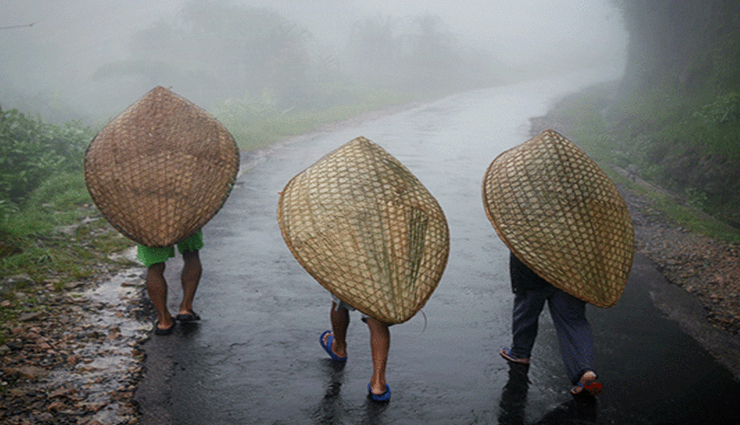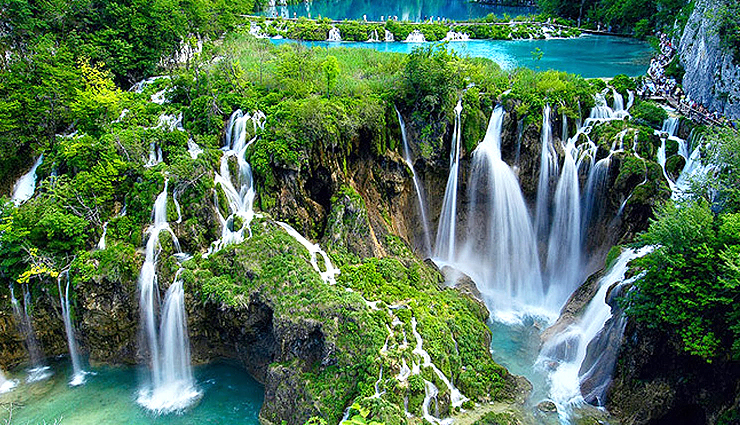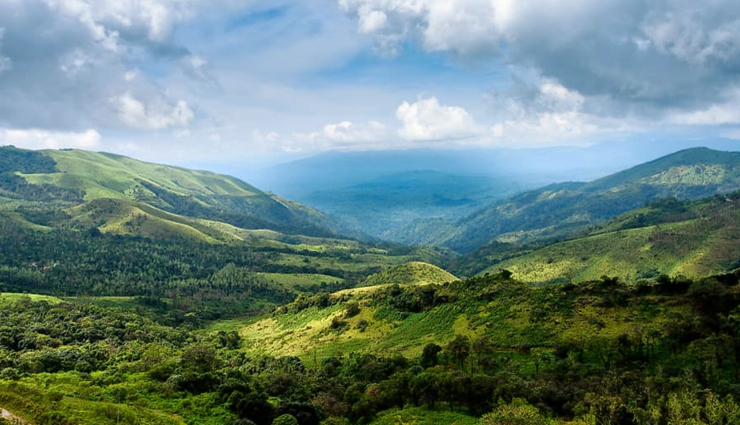6 Places With Most Rainfall In India
By: Priyanka Maheshwari Fri, 02 June 2023 12:39:49

India is a country with diverse geography, and rainfall plays a crucial role in shaping its climate and ecosystem. The monsoon season, which generally lasts from June to September, is the primary source of rainfall for most parts of India. This period is characterized by the southwest monsoon winds, which bring moisture from the Indian Ocean and Arabian Sea, resulting in widespread precipitation across the country.
The monsoon rainfall is vital for agriculture, as it nourishes crops and supports the livelihoods of millions of farmers. However, the distribution of rainfall varies across different regions of India, with some areas receiving heavy downpours while others experience more moderate or limited rainfall. This variability influences the agricultural patterns, water resources, and overall climate conditions in different parts of the country.
The monsoon is a highly anticipated weather phenomenon in India, playing a vital role in the country's climate and agriculture. It refers to the seasonal winds that bring heavy rainfall to the Indian subcontinent. The Southwest Monsoon is the primary monsoon season in India, typically occurring from June to September. It is caused by the differential heating of land and sea surfaces, which creates low-pressure areas and attracts moisture-laden winds from the Indian Ocean and Arabian Sea. These winds traverse the country, bringing much-needed rain to replenish water sources, nourish crops, and support the overall ecosystem.
The monsoon rainfall is crucial for India's agriculture, as a significant portion of the population relies on farming for their livelihoods. However, the monsoon is known for its variability, with some years experiencing excess or deficient rainfall, which can impact agricultural productivity, water availability, and the overall economy. The monsoon holds immense cultural significance in India, celebrated through festivals and traditions that highlight the importance of rain for the well-being and prosperity of the country.
India offers several beautiful destinations with high rainfall that are known for their lush green landscapes and picturesque surroundings. Here are a few places you might consider visiting:

# Mawsynram, Meghalaya
Mawsynram, located in the state of Meghalaya, India, is known for receiving the highest recorded rainfall in the world. Here's some information about Mawsynram and its rainfall:
Rainfall Record: Mawsynram has the Guinness World Record for the greatest average yearly rainfall. The annual average rainfall in the region is around 11,871 millimetres (467.4 inches). This heavy rainfall is due to the region's geographical position and the monsoon winds that blow through it.
Wettest Place on Earth: Mawsynram is known as the "Wettest Place on Earth." The unusual terrain of the region, including adjacent hills and valleys, adds to the significant rainfall. From June through September, the monsoon season provides heavy rains that convert the countryside into a beautiful green paradise.
Living Root Bridges: Mawsynram, like its neighbour Cherrapunji, is noted for its live root bridges. These amazing constructions are made by manipulating the roots of trees, specifically the Ficus elastica, to make strong natural bridges spanning rivers and streams. Mawsynram's high rainfall encourages the formation of these live root bridges, adding to the area's natural beauty.
Scenic Beauty: Mawsynram is blessed with breathtaking natural beauty. The hills and valleys surrounding the village are covered in dense foliage, giving rise to picturesque landscapes. The rain-washed vegetation, glistening waterfalls, and misty surroundings create a magical atmosphere that attracts nature lovers and adventure enthusiasts.
Adventure Activities: Despite the heavy rainfall, Mawsynram offers various adventure activities for visitors. Trekking through the scenic trails, exploring caves, and venturing into the lush forests are popular activities. The Nohkalikai Falls, one of the tallest waterfalls in India, is located nearby and provides a stunning backdrop for nature walks and photography.
Local Culture: Mawsynram is home to the Khasi tribe, and exploring the village allows visitors to experience their unique culture and traditions. The village offers insights into the rural way of life in Meghalaya, with its traditional houses, agricultural practices, and warm hospitality. Interacting with the locals provides an opportunity to learn about their customs, cuisine, and folklore.
Tourism and Sustainability: Mawsynram is quickly gaining appeal among travellers looking for unique experiences. Efforts are being undertaken to encourage sustainable tourism in the region, assuring the preservation of the fragile ecological and cultural legacy. To maintain the delicate balance between tourism and the natural environment, responsible tourist practises are promoted.

# Cherrapunji, Meghalaya
Cherrapunji, located in the state of Meghalaya, India, holds the record for the highest recorded rainfall in a calendar year. Here's some information about the rainfall in Cherrapunji:
Highest Average Annual Rainfall: Cherrapunji experiences extraordinarily heavy rainfall every year, making it one of the wettest spots on the planet. The yearly rainfall in the region is around 11,777 millimetres (463.7 inches). This plentiful rainfall is due to the region's distinctive physical features, such as the surrounding hills and the direction of monsoon winds.
Monsoon Season: The majority of Cherrapunji's rainfall falls during the monsoon season, which lasts from June to September. During this period, the area sees strong rains, which are frequently accompanied by thunderstorms. The lush flora, mist-covered hills, and running rivers form a stunning panorama.
Living Root Bridges: Heavy rainfall at Cherrapunji and the surrounding surroundings aids in the growth of remarkable living root bridges. These natural wonders are formed by directing the roots of trees, specifically the Ficus elastica, over rivers and streams to make robust bridges. These bridges have become major tourist attractions, highlighting the region's natural beauty and peaceful interaction with nature.
Waterfall Paradise: The consistent rainfall in Cherrapunji has led to the formation of numerous waterfalls in the area. Visitors can witness the breathtaking beauty of waterfalls like Nohkalikai Falls, Seven Sisters Falls, Dainthlen Falls, and many more. The cascading waters against the backdrop of lush greenery make for a truly mesmerizing sight.
Ecological Importance: The abundant rainfall in Cherrapunji plays a crucial role in supporting the region's diverse ecosystem. The rain sustains the dense forests, nurtures a variety of flora and fauna, and helps maintain the region's biodiversity. The water supply from Cherrapunji's rainfall also contributes to the river systems and groundwater reserves in the area.

# Agumbe, Karnataka
Agumbe, located in the state of Karnataka, India, is known as the "Cherrapunji of the South" due to its significant rainfall. Here's some information about the rainfall in Agumbe:
Annual Rainfall: Agumbe experiences significant rainfall all year, with an annual rainfall of roughly 7,620 millimetres (300 inches). Because of its location in the Western Ghats, which act as a barrier to moisture-laden breezes from the Arabian Sea, the region receives a lot of rain.
Rainforest Climate: Agumbe's climate is tropical rainforest, with high humidity and constant rainfall. Because of the abundant precipitation, the region's lush woods and rich flora and wildlife thrive. The Agumbe Rainforest study Station, which conducts study on the ecology and conservation of the Western Ghats, is located at Agumbe.
Monsoon Season: The monsoon season in Agumbe typically starts in June and lasts until September. During this period, the region experiences heavy rainfall, often accompanied by thunderstorms. The showers transform the landscape into a lush green paradise, with waterfalls cascading down the hillsides and mist enveloping the valleys.
Biodiversity Hotspot: Agumbe is known for its rich biodiversity and is considered one of the biodiversity hotspots in India. The constant rainfall provides the ideal conditions for the growth of diverse plant species, including rare medicinal plants and orchids. The region is also home to a wide range of animal species, including various reptiles and amphibians.
Sunset Point: Agumbe is famous for its mesmerizing sunset views. The scenic Sunset Point in Agumbe offers panoramic vistas of the surrounding hills and valleys as the sun sets behind the lush green landscape. The combination of the golden hues of the sunset and the misty atmosphere creates a captivating sight for visitors.
Filming Location: Because of its scenic beauty and natural appeal, Agumbe has been a favourite filming site for films and television series. It has served as the setting for a number of notable productions, including the legendary television series "Malgudi Days."

# Valparai, Tamil Nadu
Valparai, located in the state of Tamil Nadu, India, experiences moderate to heavy rainfall throughout the year. Here's some information about the rainfall in Valparai:
Annual Rainfall: Valparai receives a substantial quantity of rainfall each year, with an average of 3,000 to 3,500 millimetres (118 to 138 inches). The region's position in the Western Ghats' Anaimalai Hills adds to its abundant precipitation.
Southwest Monsoon: Valparai is subject to the southwest monsoon, which occurs from June to September. The area receives the majority of its rainfall during this time. The monsoon rains add to Valparai's natural splendour, converting the surrounding hills and tea gardens into lush green sceneries.
Refreshing Climate: The rainfall in Valparai contributes to its pleasant and refreshing climate. The region enjoys cool temperatures throughout the year, with average temperatures ranging from 15 to 25 degrees Celsius (59 to 77 degrees Fahrenheit). The rainfall adds to the charm of Valparai, making it a perfect destination for nature lovers and those seeking respite from the heat.
Tea Plantations: Valparai is known for its extensive tea plantations, which thrive in the region's favorable climate and abundant rainfall. The rain-washed tea estates create a picturesque setting, offering scenic views of rolling hills covered with vibrant green tea bushes. Visitors can explore the plantations, learn about tea processing, and even indulge in tea tasting experiences.
Waterfalls: The rainfall in Valparai gives rise to numerous waterfalls that dot the region. The Athirapally Falls and the Sholayar Dam are popular attractions known for their stunning cascades. The waterfalls gain volume and beauty during the monsoon season, attracting tourists and nature enthusiasts.
Wildlife Sanctuary: The Indira Gandhi Wildlife Sanctuary is located in Valparai and contains a large area of lush woods, meadows, and valleys. The sanctuary is well-known for its rich wildlife, which includes elephants, leopards, gaur (Indian bison), and a variety of bird species. The rain in Valparai nourishes the sanctuary's environment, offering a home for a variety of plants and wildlife.

# Chikmagalur, Karnataka
Chikmagalur, located in the state of Karnataka, India, is known for its pleasant climate and lush green landscapes, which are attributed to its significant rainfall. Here's some information about the rainfall in Chikmagalur:
Annual Rainfall: Chikmagalur receives a significant quantity of rainfall each year, with an average rainfall of 2,500 to 3,500 millimetres (98 to 138 inches). The position of the territory in the Western Ghats, as well as its height, contribute to the region's plentiful precipitation.
Southwest Monsoon: Chikmagalur is subject to the southwest monsoon, which usually begins in June and lasts until September. The area receives the majority of its rainfall during this season. Monsoon rains revitalise the environment, converting coffee plantations, woods, and hills into bright colours of green.
Coffee Plantations: Chikmagalur is well-known for its coffee plantations, and rainfall is critical in coffee growing. The lush soil of the area, along with the abundant rainfall, produces great circumstances for coffee growth. Visitors may tour the estates, learn about the coffee-making process, and even sip freshly brewed coffee among stunning scenery.
Scenic Waterfalls: The rainfall in Chikmagalur gives rise to several beautiful waterfalls that are worth exploring. Some notable waterfalls include the Jhari Waterfalls, Hebbe Falls, and Manikyadhara Falls. These cascading falls offer a refreshing sight and a perfect backdrop for nature enthusiasts and photographers.
Biodiversity and Wildlife: The region's rainfall supports a diverse biodiversity, with various plant and animal species living there. The woods and nature reserves in and around Chikmagalur are home to a diverse range of animals, including elephants, tigers, leopards, and a variety of bird species. Rainfall nourishes the ecology, making it a refuge for nature lovers and animal aficionados.
Pleasant Climate: Chikmagalur's rains contributes to its nice environment all year. The location has milder temperatures than the surrounding plains, making it a perfect destination for anyone looking for some relief from the heat. The mix of low temperatures and rich foliage produces a relaxing and peaceful atmosphere.

# Mahabaleshwar, Maharashtra
Mahabaleshwar, located in the state of Maharashtra, India, is known for its pleasant climate and abundant rainfall. Here's some information about the rainfall in Mahabaleshwar:
Annual Rainfall: Mahabaleshwar receives a significant amount of rainfall annually, with an average rainfall of approximately 5,000 to 6,000 millimeters (197 to 236 inches). The region's location in the Western Ghats and its high elevation contribute to its ample precipitation.
Monsoon Season: Mahabaleshwar experiences the southwest monsoon, which typically begins in June and lasts until September. During this period, the region receives the majority of its rainfall. The monsoon showers enhance the natural beauty of Mahabaleshwar, transforming the surrounding hills, valleys, and forests into lush green landscapes.
Strawberries and Mulberries: The rainfall in Mahabaleshwar is critical for strawberry and mulberry farming. Visitors may go strawberry picking or savour freshly created strawberry-based dishes in the area, which is famed for its strawberry fields. Mulberries are also widely farmed in the region, and you may get jams, syrups, and wines created from these delectable berries.
Waterfalls: Mahabaleshwar's plentiful rainfall causes the development of several waterfalls that dot the landscape. Tourists go to waterfalls such as Lingmala Falls, Dhobi Falls, and Chinaman's Falls. The flowing rivers against the backdrop of lush hills make a stunning scene for tourists.
Viewpoints and Vantage Points: Mahabaleshwar has stunning perspectives and vantage points with sweeping views of the surrounding surroundings. Wilson Point, Arthur's Seat, and Kate's Point are just a few of the overlooks from where you may take in breathtaking views of the valleys, hills, and clouds, especially during the monsoon season when the scenery is at its most colourful.
Evergreen Forests: The rainfall in Mahabaleshwar supports the region's evergreen forests, which are home to a diverse range of flora and wildlife. The woodlands provide a tranquil and serene setting for nature enthusiasts to explore and appreciate the area's natural splendour.
These are just a few examples of regions in India that receive a lot of rain and have stunning natural beauty. To make the most of your vacation, check the weather forecast and plan your visit appropriately.





